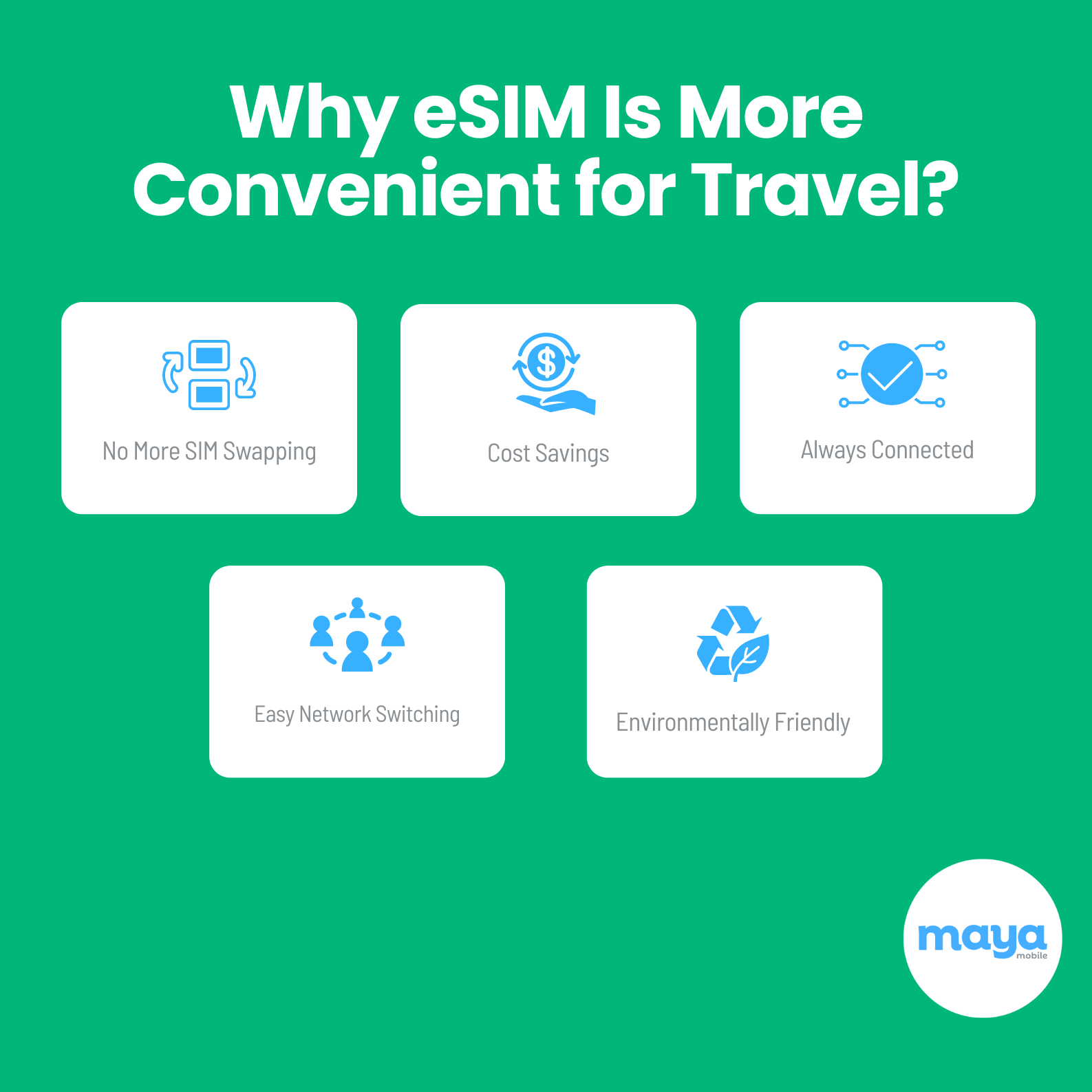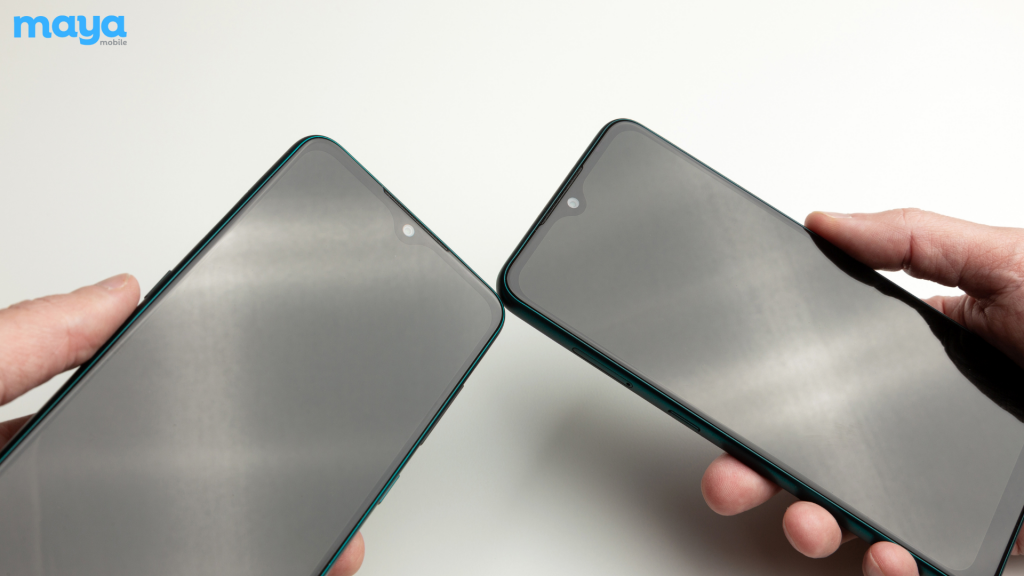Want to know how you can stay connected while traveling abroad? Whether you’re navigating unfamiliar streets, keeping in touch with friends and family, or checking important details on the go, having reliable mobile connectivity is essential when you’re away from home.
In the past, travelers needed physical SIM cards to stay connected, but now eSIM technology is quickly becoming the go-to option. According to the eSIM global market report, the eSIM market is growing quickly, with a value of $9.69 billion in 2023, expected to rise to $11 billion by 2024, and projected to reach $17.91 billion by 2028.
With this data, along with your personal experience in using a physical SIM, let’s break down which one is more convenient for travel.
What is eSIM?
An eSIM (short for embedded SIM) is a virtual SIM that’s built directly into your device. Instead of inserting a physical card, you can activate and switch networks electronically. This makes eSIMs especially convenient for travelers who can easily download new carrier profiles when moving between countries. It’s easy to learn how to use them.
What is a Physical Sim?
On the other hand, a physical SIM card is a small chip you manually insert into your phone to connect to a mobile network. It comes in different sizes (macro, micro, nano) and is often swapped out when changing carriers or countries. Physical SIMs are still widely available and commonly used, especially in areas where eSIM technology isn’t fully supported yet.
eSIM vs Physical SIM: A Quick Comparison
Stuck between eSIM and physical SIM? Here’s a breakdown of their differences.
| Criteria | eSIMs | Physical SIMs |
| Flexibility to Switch Plans | Instantly switch between carriers and plans | Requires physical swapping between SIM cards |
| Cost-Effective | Avoids roaming charges with local data plans | May incur roaming charges |
| Security | Better security; cannot be physically removed | Can be removed and stolen |
| Setup Complexity | More complex (QR codes, apps) | Simple, just insert SIM card |
| Availability | Not supported in all countries/carriers | Widely available, especially in countries without eSIM support |
| Support for Older Devices | Not compatible with older phones | Necessary for older phones |
| Risk of Loss or Damage | Embedded, no risk of loss or damage | Can be lost or damaged |
| Inconvenience of Purchasing New SIMs | There is no need to buy new SIMs when switching countries | Need to buy a new SIM card when visiting new countries |
eSIMs offer flexibility and convenience, while physical SIMs are widely supported and easy to switch between devices. The best option depends on your needs and your device. As technology advances, eSIMs may become more common, but for now, both choices serve their purpose well.
The Transition from Physical SIM to eSIM
SIM technology has transformed alongside the development of mobile devices. Here’s a quick look at the key milestones of transitioning from physical SIM to eSIM:
- Macro-SIM: Early mobile phones used large, credit card-sized SIMs, which required bulky slots.
- Mini-SIM: As phones became smaller, mini-SIM cards emerged, reducing the size while still taking up significant space.
- Micro-SIM: Further miniaturization led to the micro-SIM, which was widely used in earlier smartphones.
- Nano-SIM: Then, nano-SIMs became the standard, offering a much smaller form factor, allowing for sleeker phone designs.
- eSIM: The latest advancement is the embedded SIM (eSIM), built directly into devices. It allows users to activate and switch plans digitally without needing to swap physical cards.
Now, with the rise of eSIM technology, expected to grow from $1.7 billion in 2024 to over $8.7 billion by 2028, the need for physical SIM cards is gradually diminishing. This shift saves space inside devices, enhances security, and offers greater flexibility for users, especially travelers. As eSIM adoption grows, the future of mobile connectivity will become even more streamlined and efficient.
eSIM vs Physical SIM: Which is More Convenient for Travelers?
When comparing eSIM and physical SIM for travel, eSIM is generally the more convenient option. Here’s why:
- Easy Setup: With eSIM, you can switch between carriers or activate a new plan online, often before you even arrive at your destination, eliminating the need to find a local SIM card vendor.
- Multiple Profiles: eSIM allows you to store multiple plans on one device, letting you switch between home and local networks seamlessly without carrying or swapping SIM cards.
- Space-saving: No need to worry about losing tiny physical SIM cards. eSIM eliminates the need for storage or extra slots in your phone.
- Improved Security: eSIMs are harder to steal or clone, enhancing security when traveling.
Conclusion: For frequent travelers, eSIM offers flexibility, ease of use, and better security compared to traditional physical SIM cards, making it the clear winner.
Why eSIM Is More Convenient for Travel?
Now that we’ve seen how quickly the eSIM market is growing, let’s explore the benefits of eSIMS, why they are becoming the preferred choice for travelers, and how they offer greater convenience.


1. No More SIM Swapping
With a physical SIM, when you land in a new country, you usually need to buy a local SIM card, remove your current one, and replace it. With an eSIM, that hassle is gone. You can switch networks or activate local plans with just a few taps on your phone. No more fumbling with tiny SIM cards or worrying about losing them.
2. Cost Savings
Data roaming charges can be expensive when using a physical SIM abroad. An eSIM lets you easily access local data plans, saving you from high roaming fees. You can activate a roaming plan when you arrive, ensuring you get the best rates possible. Never heard of roaming data? Check out what data roaming is.
3. Always Connected
With eSIM, you don’t have to worry about finding a store to buy a SIM card upon arrival. You’re connected as soon as you land, so you can book rides, look up maps, or send a quick message without interruption. The seamless global connectivity also ensures you stay connected no matter where you go.
4. Easy Network Switching
If you find a better deal with a different local provider, you can switch to their network easily with an eSIM, all without needing to buy a new SIM card. This flexibility allows you to compare data plans and choose what works best for your travel needs.
5. Environmentally Friendly
Using an eSIM means fewer physical SIM cards being manufactured and discarded, which helps reduce plastic waste. It’s a small step, but every little bit helps when it comes to reducing environmental impact.
Devices That Use eSIM


eSIM vs. Physical SIM: So, Which is Better?
In conclusion, while both eSIMs and physical SIM cards have their benefits, eSIMs are becoming the better choice for most travelers. They offer convenience and flexibility, allowing you to switch carriers and activate plans quickly, without needing to deal with physical cards. For people who want an easy and modern solution, eSIMs make travel much simpler.
If your phone supports eSIM, using Maya Mobile on your next trip can save time and avoid the hassle of swapping SIM cards. Physical SIMs are still useful in areas with limited eSIM support or for older phones, but overall, eSIMs through Maya Mobile are the smarter and more convenient option for most travelers.
FAQs on eSIM vs. Physical SIM
Is eSIM better than physical SIM?
It depends on your needs. eSIM is more convenient for travelers and those who switch carriers often, as it allows instant plan changes without handling physical cards. However, physical SIMs are widely available and work in areas where eSIM isn’t supported yet.
Can eSIMs be used simultaneously with physical SIMs in the same device?
Yes, eSIMs can be used alongside physical SIMs in many modern devices. This feature is called Dual SIM functionality, allowing you to have two active numbers or plans at the same time. For example, you can use an eSIM for your home carrier and a physical SIM for a local plan when traveling. This flexibility makes managing multiple lines or switching networks easier without needing two separate devices.
Is it worth switching to eSIM?
Yes, if you travel frequently or switch between carriers often. eSIM offers flexibility and better security and eliminates the need for carrying physical SIM cards. However, if you live in a region with limited eSIM support, sticking to a physical SIM may be better.
How does eSIM technology improve productivity for business travelers?
eSIM simplifies connectivity by allowing business travelers to switch between local carriers without visiting stores or carrying multiple SIM cards. This saves time, reduces roaming costs, and ensures a reliable connection, making it easier to stay productive while on the go.
How does eSIM work?
An eSIM works by being embedded directly into your device, so there’s no need for a physical card. It stores your mobile network information digitally.
To set it up, you either scan a QR code or download an app from your carrier, and the eSIM gets activated on your phone. Once it’s activated, you can switch between carriers or plans directly
What is the disadvantage of eSIM?
One downside of eSIM is that it’s not as easily transferable as a physical SIM. If your phone breaks or you switch devices, transferring your eSIM can be tricky and may require contacting your carrier. Also, not all phones and carriers support eSIM yet, which limits compatibility.
Does eSIM drain the battery?
No, eSIM doesn’t significantly drain more battery compared to physical SIM cards. Battery usage mainly depends on factors like network strength and phone usage, not whether you’re using an eSIM or a physical SIM.
Why is eSIM not popular?
eSIM is still relatively new, and many people are used to physical SIM cards. Not all carriers or devices support eSIM yet, which slows adoption. Plus, some users may be hesitant due to concerns about the ease of switching devices or networks.




